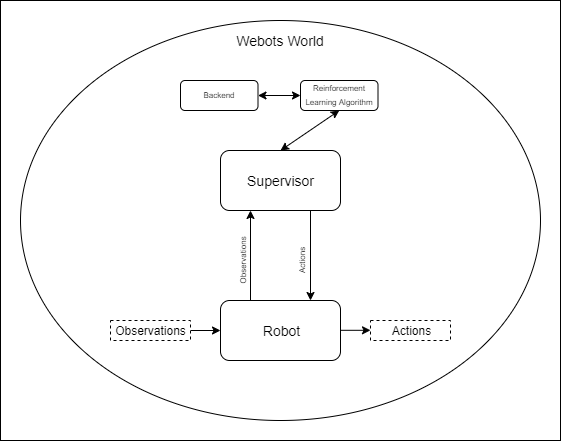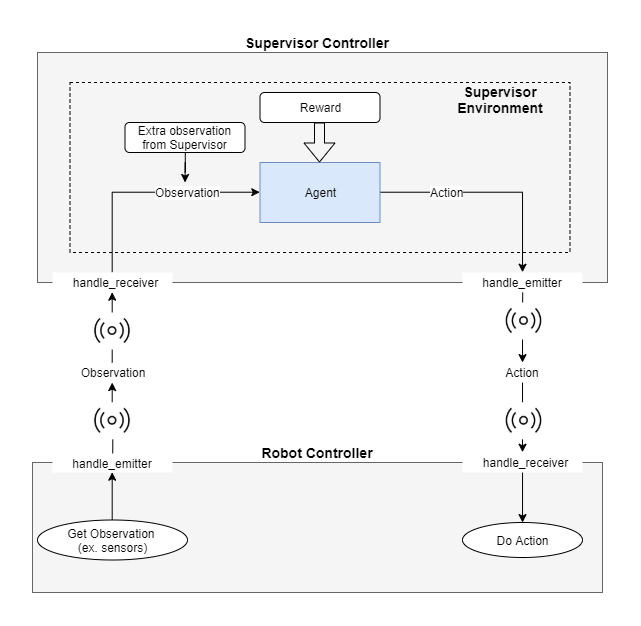Deepbots is a simple framework which is used as "middleware" between the free and open-source Cyberbotics' Webots robot simulator and Reinforcement Learning algorithms. When it comes to Reinforcement Learning the OpenAI gym environment has been established as the most used interface between the actual application and the RL algorithm. Deepbots is a framework which follows the OpenAI gym environment interface logic in order to be used by Webots applications.
- Install Webots
- Install Python version 3.X (please refer to Using Python to select the proper Python version for your system)
- Follow the Using Python guide provided by Webots
- Webots provides a basic code editor, but if you want to use PyCharm as your IDE refer to using PyCharm IDE provided by Webots
You will probably also need a backend library to implement the neural networks, such as PyTorch or TensorFlow. Deepbots interfaces with RL agents using the OpenAI gym logic, so it can work with any backend library you choose to implement the agent with and any agent that already works with gym.
Deepbots can be installed through the package installer pip running the following command:
pip install deepbots
- On the deepbots-tutorials repository you can find the official tutorials for deepbots
- On the deepworlds repository you
can find examples of deepbots being used.
Feel free to contribute your own!
Conference paper (AIAI2020): https://link.springer.com/chapter/10.1007/978-3-030-49186-4_6
@InProceedings{10.1007/978-3-030-49186-4_6,
author="Kirtas, M.
and Tsampazis, K.
and Passalis, N.
and Tefas, A.",
editor="Maglogiannis, Ilias
and Iliadis, Lazaros
and Pimenidis, Elias",
title="Deepbots: A Webots-Based Deep Reinforcement Learning Framework for Robotics",
booktitle="Artificial Intelligence Applications and Innovations",
year="2020",
publisher="Springer International Publishing",
address="Cham",
pages="64--75",
abstract="Deep Reinforcement Learning (DRL) is increasingly used to train robots to perform complex and delicate tasks, while the development of realistic simulators contributes to the acceleration of research on DRL for robotics. However, it is still not straightforward to employ such simulators in the typical DRL pipeline, since their steep learning curve and the enormous amount of development required to interface with DRL methods significantly restrict their use by researchers. To overcome these limitations, in this work we present an open-source framework that combines an established interface used by DRL researchers, the OpenAI Gym interface, with the state-of-the-art Webots robot simulator in order to provide a standardized way to employ DRL in various robotics scenarios. Deepbots aims to enable researchers to easily develop DRL methods in Webots by handling all the low-level details and reducing the required development effort. The effectiveness of the proposed framework is demonstrated through code examples, as well as using three use cases of varying difficulty.",
isbn="978-3-030-49186-4"
}
First of all let's set up a simple glossary:
-
World: Webots uses a tree structure to represent the different entities in the scene. The World is the root entity which contains all the entities/nodes. For example, the world contains the Supervisor and Robot entities as well as other objects which might be included in the scene. -
Supervisor: The Supervisor is an entity which has access to all other entities of the world, while having no physical presence in it. For example, the Supervisor knows the exact position of all the entities of the world and can manipulate them. Additionally, the Supervisor has the Supervisor Controller as one of its child nodes. -
Supervisor Controller: The Supervisor Controller is a python script which is responsible for the Supervisor. For example, in the Supervisor Controller script the distance between two entities in the world can be calculated. -
Robot: The Robot is an entity that represents a robot in the world. It might have sensors and other active components, like motors, etc. as child entities. Also, one of its children is the Robot Controller. For example, epuck and TIAGo are robots. -
Robot Controller: The Robot Controller is a python script which is responsible for the Robot's movement and sensors. With the Robot Controller it is possible to observe the world and act accordingly. -
Environment: The Environment is the interface as described by the OpenAI gym. The Environment interface has the following methods:-
get_observations(): Return the observations of the robot. For example, metrics from sensors, a camera image etc. -
step(action): Each timestep, the agent chooses an action, and the environment returns the observation, the reward and the state of the problem (done or not).
-
get_reward(action): The reward the agent receives as a result of their action. -
is_done(): Whether it’s time to reset the environment. Most (but not all) tasks are divided up into well-defined episodes, and done being True indicates the episode has terminated. For example, if a robot has the task to reach a goal, then the done condition might happen when the robot "touches" the goal. -
reset(): Used to reset the world to the initial state.
-
In order to set up a task in Deepbots it is necessary to understand the
intention of the OpenAI gym environment. According to the OpenAI gym
documentation, the framework follows the classic “agent-environment loop”.
"Each timestep, the agent chooses an action, and the environment returns an
observation and a reward. The process gets started by calling reset(),
which returns an initial observation."
Deepbots follows this exact agent-environment loop with the only difference
being that the agent, which is responsible to choose an action, runs on the
Supervisor and the observations are acquired by the robot. The goal of the
deepbots framework is to hide this communication from the user, especially from
those who are familiar with the OpenAI gym environment. More specifically,
SupervisorEnv is the interface which is used by the Reinforcement Learning
algorithms and follows the OpenAI Gym environment logic. The Deepbots framework
provides different levels of abstraction according to the user's needs.
Moreover, a goal of the framework is to provide different wrappers for a wide
range of robots. Currently, the communication between the Supervisor and the
Robot is achieved via an emitter and a receiver.
On one hand, the emitter is an entity, which is provided by Webots, that
broadcasts messages to the world. On the other hand, the receiver is an
entity that is used to receive messages from the world. Consequently, the
agent-environment loop is transformed accordingly. Firstly, the Robot uses its
sensors to retrieve the observation from the World and in turn uses the emitter
component to broadcast this observation. Secondly, the Supervisor receives the
observation via the receiver component and in turn, the agent uses it to choose
an action. It should be noted that the observation the agent uses might be
extended from the supervisor. For example, a model might use lidar sensors
installed on the Robot, but also the euclidean distance between the Robot and
an object. As it is expected, the Robot does not know the euclidean distance,
only the Supervisor can calculate it, because it has access to all entities in
the World.
The deepbots framework has been created mostly for educational purposes. The
aim of the framework is to enable people to use Reinforcement Learning in
Webots. More specifically, we can consider deepbots as a wrapper of Webots
exposing an OpenAI gym style interface. For this reason there are multiple
levels of abstraction. For example, a user can choose if they want to use CSV
emitter/receiver or if they want to make a from scratch implementation. In the
top level of the abstraction hierarchy is the SupervisorEnv which is the
OpenAI gym interface. Below that level there is an actual implementation. This
implementation aims to hide the communication between the Supervisor and the
Robot. Similarly, the Robot also has different abstraction levels.
According to their needs, users can choose either to process the messages
received from the Supervisor themselves or use the existing implementations.


